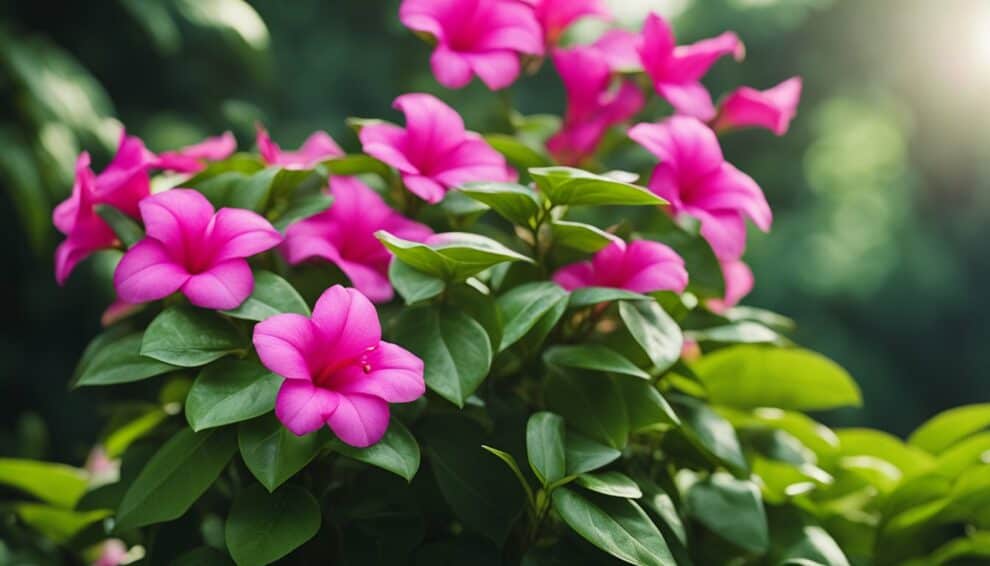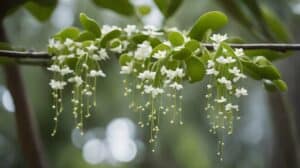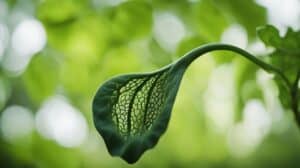Dipladenia Sanderi, also known as Mandevilla, is a popular flowering plant that is native to South America.
It is a vine that produces stunning blooms in shades of pink, red, and white.
With its easy care requirements, it has become a favorite among gardeners and plant enthusiasts alike.

If you’re looking to add some color and beauty to your garden or indoor space, Dipladenia Sanderi is a great choice.
This plant is low maintenance and can thrive in a variety of conditions, making it perfect for beginners and seasoned gardeners alike.
In this article, you’ll find some easy care tips that will help you keep your Dipladenia Sanderi healthy and blooming all season long.
Understanding Dipladenia Sanderi
Species Overview
Dipladenia Sanderi, also known as Mandevilla Sanderi, is a popular tropical plant species that belongs to the Apocynaceae family.
It is native to South America and is widely cultivated for its stunning and vibrant blooms.
The plant is a woody vine that can grow up to 10 feet long and produces trumpet-shaped flowers that come in various colors such as pink, red, and white.
Growth Habit
Dipladenia Sanderi is a fast-growing plant that requires full sun and well-draining soil.
It is highly adaptable and can thrive in a range of temperatures and humidity levels. The plant can be grown in containers or planted directly in the ground.
When grown in containers, it is important to ensure that the container is large enough to accommodate the plant’s root system.
Dipladenia Sanderi is a low-maintenance plant that requires minimal care.
It is important to water the plant regularly, especially during hot and dry weather conditions.
Fertilization should be done every two weeks during the growing season to promote healthy growth and blooming.
Pruning should be done in the spring to remove any dead or damaged branches.
Overall, Dipladenia Sanderi is a beautiful and easy-to-care-for plant that can add a touch of tropical beauty to any garden or indoor space.
Essential Care Tips

Watering Requirements
Dipladenia Sanderi requires moderate watering. Overwatering can lead to root rot, while under-watering can cause the leaves to wilt.
Water the plant when the top inch of soil feels dry to the touch.
It is recommended to water the plant deeply, allowing the water to drain out of the bottom of the pot.
Avoid getting water on the leaves, as this can cause fungal diseases.
Sunlight and Temperature
Dipladenia Sanderi thrives in full sunlight, but it can also tolerate partial shade. It prefers temperatures between 60-80°F (15-27°C).
If the temperature drops below 50°F (10°C), the plant may stop growing and drop its leaves.
It is important to protect the plant from strong winds and frost.
Soil and Fertilization
Dipladenia Sanderi prefers well-draining soil that is rich in organic matter. A mixture of potting soil and perlite or sand can be used.
Fertilize the plant every 2-3 weeks during the growing season with a balanced fertilizer.
Avoid over-fertilizing, as this can lead to salt buildup in the soil.
Pruning and Maintenance
Dipladenia Sanderi can be pruned to maintain its shape and promote new growth. Prune the plant in early spring before new growth appears.
Remove any dead, damaged, or diseased branches. Pinch back the tips of the stems to encourage branching. The plant can be trained to climb a trellis or support.
Regularly check the plant for pests and diseases, and treat promptly if necessary.
Troubleshooting Common Issues

Pest Problems
Dipladenia Sanderi is generally a hardy plant, but it can be susceptible to a few pests. Here are some common pests to look out for:
- Spider Mites: These tiny pests can be identified by their web-like structures on the plant.
They can be controlled by spraying the plant with water or using an insecticidal soap.
- Whiteflies: These small, white insects can be found on the undersides of leaves.
They can be controlled by using sticky traps or insecticidal soap.
- Mealybugs: These small, white, cottony insects can be found on the stems and leaves of the plant.
They can be controlled by using a cotton swab dipped in rubbing alcohol to remove them.
Diseases and Disorders
Dipladenia Sanderi is also susceptible to a few diseases and disorders. Here are some common ones to look out for:
- Leaf Spot: This disease is characterized by brown spots on the leaves.
It can be controlled by removing infected leaves and using a fungicide.
- Powdery Mildew: This disease is characterized by a white, powdery substance on the leaves.
It can be controlled by removing infected leaves and using a fungicide.
- Yellowing Leaves: This can be caused by overwatering or underwatering the plant.
Make sure to water the plant when the top inch of soil is dry, and make sure the pot has proper drainage.
By keeping an eye out for these common issues and taking the appropriate steps to control them, Dipladenia Sanderi can thrive and produce stunning blooms.
Encouraging Vibrant Blooms

Optimal Blooming Conditions
To encourage Dipladenia Sanderi to produce stunning blooms, it is important to provide them with the right growing conditions.
These plants thrive in warm, humid environments with plenty of sunlight. They do well in well-draining soil that is rich in organic matter.
To ensure optimal blooming conditions, keep the following tips in mind:
-
Temperature: Dipladenia Sanderi prefers temperatures between 65 and 80 degrees Fahrenheit.
Keep them in a warm, sunny spot, and avoid exposing them to temperatures below 50 degrees Fahrenheit.
-
Humidity: These plants require high humidity levels to thrive.
Use a humidifier or place a tray of water near the plant to increase humidity levels.
-
Light: Dipladenia Sanderi needs plenty of sunlight to produce blooms.
Place them in a spot that receives at least six hours of direct sunlight each day.
-
Soil: Use a well-draining soil mix that is rich in organic matter. Avoid using heavy soils that retain too much moisture.
Bloom Boosting Techniques
In addition to providing optimal growing conditions, there are several techniques you can use to encourage Dipladenia Sanderi to produce stunning blooms.
Here are a few tips to keep in mind:
-
Fertilizer: Use a high-phosphorus fertilizer every two weeks during the growing season to encourage blooming.
-
Deadheading: Remove spent blooms regularly to encourage the plant to produce new blooms.
-
Pruning: Prune the plant regularly to promote new growth and encourage blooming.
-
Pest Control: Keep an eye out for pests such as spider mites and aphids, which can damage the plant and prevent it from producing blooms.
By following these easy care tips, you can encourage Dipladenia Sanderi to produce stunning blooms all season long.
Frequently Asked Questions

What are the best practices for watering Dipladenia plants for optimal blooming?
Dipladenia plants should be watered thoroughly but infrequently. Overwatering can lead to root rot and other issues.
The soil should be allowed to dry out slightly between waterings.
It is also important to avoid getting water on the leaves, as this can lead to fungal diseases.
How should Dipladenia be cared for during the winter months?
Dipladenia is a tropical plant and is sensitive to cold temperatures. It should be brought indoors before the first frost and kept in a warm, well-lit area.
Watering should be reduced during the winter months, but the soil should not be allowed to dry out completely.
What are the ideal conditions for growing Dipladenia indoors?
Dipladenia plants require bright, indirect sunlight and well-draining soil.
They should be kept in a warm, humid environment, and the soil should be kept moist but not waterlogged.
Fertilizer should be applied every two weeks during the growing season.
Can Dipladenia thrive in containers, and if so, how should they be potted?
Dipladenia can be grown in containers, but it is important to choose a container that is large enough to accommodate the plant’s root system.
The container should have drainage holes to prevent water from accumulating in the soil.
A well-draining potting mix should be used, and the plant should be watered and fertilized regularly.
What techniques can be used to encourage a Dipladenia plant to produce more flowers?
Dipladenia plants can be encouraged to produce more flowers by deadheading spent blooms and providing adequate sunlight and water.
Fertilizer can also be applied every two weeks during the growing season to promote healthy growth and blooming.
How can I promote a bushier growth in my Dipladenia?
To promote bushier growth in Dipladenia plants, pinch back the tips of the stems regularly.
This will encourage the plant to branch out and produce more foliage.
Fertilizer can also be applied every two weeks during the growing season to promote healthy growth.














